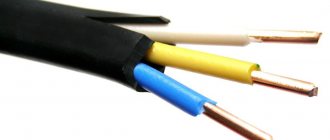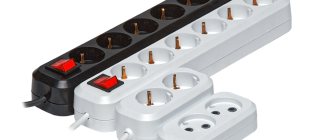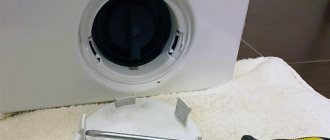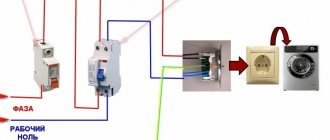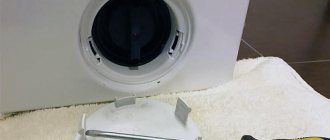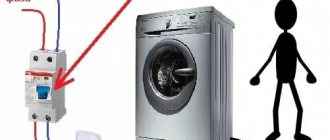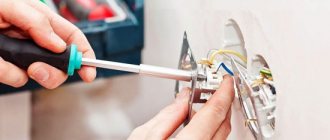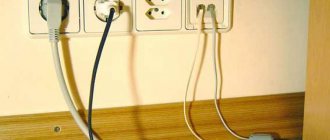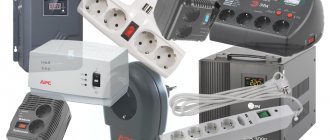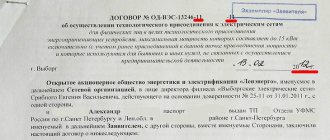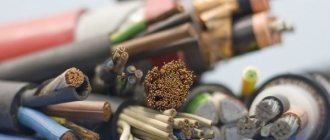Manufacturers of large household appliances are categorically against connecting washing machines to an outlet via an extension cord. Electricians also share the same opinion, since an additional link between the equipment and the electrical network can cause a fire.
When the washing machine is located far from the outlet, this connection method is the only possible one. If you choose the right extension cord for your washing machine, you can minimize the risks of an emergency. We'll tell you which device is better to buy.
How to choose an extension cord for a washing machine
If you cannot do without carrying, pay attention to the characteristics. For household appliances, purchase a personal extension cord that can be connected to one appliance. Choose a cable with grounding.
Many carrier models are equipped with a thinner wire than that of a washing machine. They are designed for low power. But a cable that is too thick indicates that the extension cord is intended more for professional use than for household use. The extension cord must be rated 13 amps. 10-amp and less will overheat, which makes their use dangerous.
Also be careful when choosing the wire length. It should not be too long so that you can unfold it completely. A cable that is too long will get tangled and kinked. The optimal length is from three to seven meters. Do not forget that the wire and portable socket should be located as high as possible from the floor to prevent splashes and water.
Wiring installation
The ideal option for laying electrical wiring is to place it inside the wall. Such installation involves very labor-intensive and dirty work. As an alternative, when installing wires for a washing machine, the cross-section of which we now know, you can use an electrical box (cable duct) of the required depth. It comes in the form of a white, closable plastic gutter, usually two meters long. In addition to securely fixing the wire inside using a cover with a lock, this installation method has a rather aesthetic appearance and guarantees easy and quick installation of the wiring. The socket must be protected from moisture and have a cover that covers the contacts when there is no connection.
The problematic proximity of copper and aluminum
Most older residential buildings typically use aluminum wire as the main wiring. Its direct connection to a copper cable is not allowed, because when interacting, these metals enter into a chemical reaction, as a result of which the contact point is oxidized, forming a dielectric film on the surface of the conductor. Such a connection quickly begins to heat up and, regardless of the thickness of the cross-section of the wire for the washing machine, especially under high load, inevitably leads to burnout of the contact pair. This can lead to equipment failure and even a fire. To avoid such a situation, specialized connecting clamps must be used to interface copper and aluminum conductors.
It is also now possible to calculate what wire cross-section is needed for a washing machine when using an aluminum three-core cable for power supply. With a declared load of 2.2 kW, its cross-section must be at least 3 mm2 for each thread.
Features and purpose
An extension cord for a washing machine is indispensable in cases where the equipment is installed too far from the outlet and there is no way to move it. However, in this situation, you should not use the first household device you come across - the choice should be given in favor of the safest option. Since washing machines are connected to grounding, the extension cord must be used in the same way. In principle, a similar contact group for the plug and socket is considered the main condition.
How the filter works
If a surge protector is built into a washing machine, then it can pass oscillations with a frequency of 50 Hertz , and the remaining impulses will be immediately blocked.
This is a significant point, since if we consider network outages and surges, then significant surges in amplitude can cause damage to the machine’s systems, including complete loss of performance.
When using the protective device, it is forbidden to turn off the washing machine from the outlet during operation , as the filter may break.
It doesn't matter what kind of filter there is. Any is better than none.
Is it dangerous to leave chargers in sockets?
Chargers for gadgets are used every day, so many people do not unplug them. According to the expert, this can be dangerous if we are talking about uncertified products. “Now many people save money and buy untested products that do not have a Russian certificate. Such chargers may cause a fire. Also dangerous is the phone itself, which is in the process of recharging the battery. It should be placed on the least fire-hazardous surface, for example, on a glass table, parquet or tile. Under no circumstances should it be left on the bed or upholstered furniture,” warns von Meck.
Leave a comment (0)
Should an extension cord have an RCD?
Many modern extension cords have a built-in de-energizing system. This function is called an RCD, that is, a residual current device. The mechanism is triggered when overloaded. Contrary to the misconceptions of ordinary people, an extension cord for a washing machine should not have an RCD.
Since the machine is not connected as it should, the protection system in the carrier will not work correctly. Problems and malfunctions can occur during spinning and when heating water, since it is during these processes that the machine produces a peak of power. Most likely, the RCD will not work, or will react with great delay. If household appliances are used incorrectly, and through an adapter with a long cable and built-in power outage protection, accidents may occur. If there is an overload, the wiring and socket will light up first, so protection here is also useless. And besides, if a voltage drop burns out the filter and control board, the machine itself will turn off.
Remember that the safest way to connect a washing machine is through a grounded outlet with good quality wiring. In other cases, be extremely careful.
Safe Operation
The purchased extension cord may not meet the conditions of use in some respects. But changing and improving the factory-made design is unacceptable. Compliance with the rules for using an electrical extension cord eliminates the dangers caused by a discrepancy between the specified characteristics.
It should always be remembered that
It is prohibited to use an extension cord when the parameters of the number of cable cores and the cross-section of the wires do not match, if they are smaller in size than required by the power of the washing machine.
When using the carrier, it is useful to periodically check by touch the degree of heating of the connecting nodes and wires. The room temperature of the extension cord elements indicates the absence of malfunctions.
Thus, not every electrical extension cord is suitable for a washing machine: the design must include a grounding wire, an RCD or a surge protector.
Please note that carriers require careful handling - it is not recommended to tie them in a knot, twist them, or cover them with any objects. Do not use extension cords if the socket, plug or cord is faulty; do not lay them under the carpet or across the threshold. The cable should be placed as far away from the floor as possible.
Source
How to extend the drain hose?
Step-by-step instruction:
1. Place a clamp on the end switch, then attach it to one side of the fitting.
2. Do the same on the side of the extension cord.
3. Tighten the clamps.
4. Attach the extension to the sewer pipe or drain siphon.
5. Start test mode.
See how simple it is? Shopping took longer than the process itself. This trick can also be done from the side of the inlet hose if the water pipe is located far enough away.
Necessary materials
Before you go shopping, take the necessary measurements:
- Measure the length of the distance that was not enough to the sewer pipe (siphon) to determine the length of the tube. It’s better to buy a longer one and cut off the excess than not to cut it short. Initially, SM developers calculate the length of the drain based on the power of the pump, so adding extra meters increases the load on the pump. If the distance to the sewer is three times greater than the norm, this is fraught with pump breakdowns, stagnation of water in the hose, tank, and the appearance of an unpleasant “swampy” smell in the drum.
- Measure the diameter of the drain hose. It is desirable that the diameter of the additional one coincides with the “native” one. If the extension cord is narrow, it may be torn off by the pressure and a flood may occur.
Shopping list:
1. Hose extension.
It would be great if it was the same brand as the machine, but this is not necessary. The main thing is the required length and diameter. The cost depends on the length and quality - from 9 rubles to 200 and above. For example, for 200 rubles you can buy a corrugated, sliding one and independently adjust the length from 1.5 to 5 meters.
2. Connector.
It is also called a connector or fitting. Experienced mechanics and plumbers affectionately call this spare part “brush”. When choosing a part, you will need the previously measured diameter. Since the connector is double-sided, the cross-section of each side must coincide with the ends of the hoses. The cost may vary depending on the size and material, 10–20 rubles on average.
3. Clamps.
You will need two of them - to fix the end switches on the connector. A reliable option is plumbing or automotive metal clamps. The assortment allows you to roam - a variety of materials, models, sizes. Therefore, prices vary, but it is quite possible to buy one ring for 15 rubles.
4. Phillips screwdriver. To tighten the clamps, you most likely won’t have to purchase one; this tool can be found in any home.
Why is an extension cord prohibited?
In modern apartments there are practically no problems with connecting washing machines to the electrical network. Developers carefully consider the layout of bathrooms, providing several waterproof outlets for convenient and safe installation of household appliances. But in “old” houses, communications are not so well established: access to power is standard or even located far away, in the corridor or room. If there is no way to rebuild the room, the only option left is to throw in an extension cord.
The scheme is simple: go to the nearest hardware store, buy the first extension cord you come across and turn on the washing machine through it. There is only one problem - doing this is strictly prohibited. This item is specified in each factory manual.
Manufacturers strongly do not recommend connecting the washing machine through an extension cord - this is dangerous to human life and health!
Connecting through an extension cord is considered dangerous for several reasons:
- Often an extension cord that is not suitable for power is purchased, or rather, it is too “weak” for the equipment;
- a energized “carrying device” lies on the threshold, next to the washing machine or in the corridor and, if exposed to water or touched, can give an electric shock;
- the cord connected to the socket under the door often frays, gets crushed and bent, the insulation is damaged, the wires are exposed and pose a threat to the life and health of the residents;
- Unknowingly, other devices are connected to the extension cord at the same time, which overstresses the network and results in an emergency power outage;
- Constant use of plugs of different types, especially pins that do not match in size, loosens the extension cord and does not provide a full current supply.
You can't joke with electricity. The human heart “works” from electrical impulses, and even a small surge in voltage from the outside will lead to malfunctions of the cardiovascular system. We must not forget about the fire hazard - damaged insulation and exposed wires can lead to a fire in equipment with further consequences.
Manufacturers of washing machines warn users and provide instructions for connecting the equipment to the electrical network. These include the supply of direct current of a certain power with grounding and protection from moisture. In most cases, the extension cord does not have such characteristics.
Safety precautions
In modern new buildings, developers are starting to make normal moisture-resistant sockets in the bathroom, facilitating further work on installing washing machines. But in most houses, the sockets are located somewhere in the corridor or room, and the cord of the machine is short, on average a meter and a half, no more. What to do? Resourceful people simply go to any hardware or electrical store and buy the first extension cord they like. It turns out that doing this is strictly prohibited! That's why:
Technical requirements for direct current, grounding and power lead us to the fact that we still need a separate channel with special protection from moisture.
Basic rules of application
Before connecting the washing machine to the outlet through an intermediate link, you should understand how to use the extension cord. By following the manufacturer's recommendations and basic rules, you can reduce the risk of a dangerous situation to zero.
If you have an old cable lying around at home, or you bought the wrong device, you shouldn’t go into it and try to improve it yourself. It is strictly forbidden to change the design of the factory extension cord with your own hands. This is fraught with adverse consequences.
When planning to use an electrical extension cord to connect an automatic machine, you need to remember:
- You cannot include other household appliances in it together with the washing machine;
- It is better to purchase a device whose unit has a protective cover. Due to this, splashes of water will not get into the connectors;
- When connecting an extension cord to the network, it is important to fully unfold it. A coiled wire quickly overheats and wastes power;
- the device cannot be used if the cable cross-section does not correspond to the power of the machine;
- Touch the cable during washing - it should be at room temperature. Strong heating of the wire indicates a malfunction. It is not safe to use such an extension cord.
There is no need to buy the cheapest models sold in the first supermarket you come across. It is better to overpay for a product equipped with grounding, a locking block and a residual current device.
It is important to store the extension cord correctly. It is forbidden to twist or tie it into a knot or place anything on top. Do not connect the product to a faulty outlet, if the plug or the cord itself is defective, place the cord under a carpet or rug, or “throw” it over a high threshold.
The extension cord should be positioned as far away from the floor as possible so that in the event of a leak, water does not get on conductive parts.
Safe Operation
The purchased extension cord may not meet the conditions of use in some respects. But changing and improving the factory-made design is unacceptable. Compliance with the rules for using an electrical extension cord eliminates the dangers caused by a discrepancy between the specified characteristics.
It should always be remembered that
It is prohibited to use an extension cord when the parameters of the number of cable cores and the cross-section of the wires do not match, if they are smaller in size than required by the power of the washing machine.
When using the carrier, it is useful to periodically check by touch the degree of heating of the connecting nodes and wires. The room temperature of the extension cord elements indicates the absence of malfunctions.
Thus, not every electrical extension cord is suitable for a washing machine: the design must include a grounding wire, an RCD or a surge protector.
Please note that carriers require careful handling - it is not recommended to tie them in a knot, twist them, or cover them with any objects. Do not use extension cords if the socket, plug or cord is faulty; do not lay them under the carpet or across the threshold. The cable should be placed as far away from the floor as possible.
Source
Rules for choosing ouzo
The most frequently asked question when installing and connecting washing machines: is it necessary to install an RCD for a washing machine? The answer is simple - yes, it is necessary. After all, the washing machine itself is a fairly energy-consuming device, and also operates in an environment with high humidity, due to which it belongs to the category of increased danger. That is why the installation of an RCD is necessary when connecting washing machines to the power supply network. In order for the washing machine to serve for many years, and its operation to be safe, it is important to choose the right residual current device. To do this, you must follow the following rules:
- Device power. The choice of RCD for a washing machine based on power is based on the rated power of the electrical network. There are single-phase and three-phase devices.
- Mains voltage. Single-phase RCDs are designed for 220 V, and three-phase RCDs are designed for 380 V.
- Current strength. The most common RCDs, which are recommended by experts, have 30 mA protection. It can be set to 10 mA, but a similar degree of protection is not required for household electrical equipment.
- Design features of the RCD. Since the washing machine has a high level of power consumption, it is better to choose a class A residual current device. It is also possible to install class AC, but this type does not always perform its function well.
- Features of the release and marking of the machine. An RCD marked “C” is suitable for the electrical network in an apartment or private house. There are also devices with digital markings; in this case, the correct choice would be a device with a C16 marker or, more rarely, a C25.
- Additional levels of protection. Some RCD models do not have a protection system in case of a break in the neutral conductor, which leads to the device ignoring current leaks.
Cable type
The type of wire is selected depending on the conditions in which the extension cord will operate. Among the most common options:
- PVS – the wire has a sheath of plasticized PVC, copper cores, a round cross-section, and is inexpensive, which affects the final price of the extension cord. The material is afraid of negative temperatures, becomes tanned in the cold, and is also susceptible to abrasion. For domestic conditions, when the extension cord is not particularly tugged or frozen, this type of cable is perfect. Another disadvantage is the sufficient massiveness, but it becomes critical when the core cross-section is more than 2.5 mm2;
- SHVVP It is used much less frequently and is distinguished by a flat cut. Due to the thinner insulation, the cable takes up less space. It is suitable for domestic conditions, but under heavy loads, for example, at a construction site, it may not withstand and become unusable;
- KG (flexible cable) suitable for harsh conditions. The core insulation and cable sheath are made of rubber. This cable can withstand frost and heat and is resistant to mechanical stress, which is why it is the best option for difficult construction conditions. However, such a wire should not be left in direct sunlight for a long time.
What does connection actually look like in modern realities?
Considering the complexity of work in the bathroom, our people have come up with several ways to circumvent the ban.
- Buy a personal extension cord for only one device. In fact, another socket is also a kind of carrier, but laid in the wall according to all the rules of science.
- Carrying must be of high quality and grounded! Some people make their own, while others buy them in a store. For example, it has proven itself well. Its carriers are equipped with protection; in the event of a power outage or overheating, the device will turn off and prevent expensive equipment from burning out.
- Extend the cord to the required length . But here pitfalls emerge in the form of constant exposure of the door to the wire. It will gradually wear out and there will be a risk of short circuit, electric shock or fire.
The best way is to conduct grounded wiring from the panel directly to the bathroom and not worry!
The whole truth about the residual current device
An RCD is a system for emergency blocking of electricity in a circuit built into the carrying case. When an overload occurs for various reasons, the opening and de-energizing mechanism is triggered. The device is ideal for use as a construction tool, but according to the rules it is contraindicated for a washing machine. She is a big energy consumer!
Ideally, the machine should be supplied with a high-quality cable of suitable cross-section! The power peak occurs during the spin cycle; it is at this moment that incorrect wiring causes heating and overload.
In the event of any failure in the network, the RCD will operate and prevent the equipment from permanently breaking down. But there are several reasons why you shouldn’t take the risk:
- Sometimes a current breaks through the body of the equipment. If you touch it at this moment, the RCD will work with a delay, and the person will already need emergency medical care.
- Overloading will ignite weak wiring and sockets. Protection prevents fire only half of the time...
- A sudden change in the electrical circuit can completely burn out the filter and even the control board in a split second. The RCD may not have time to react!
Yes, no one denies the usefulness of automatic protection. It should not be ignored, it is she who saves expensive devices from power surges, but constantly relying on it and connecting powerful units is dangerous.
